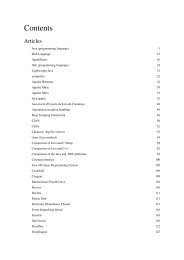Structured Query Language (SQL) - Cultural View of Technology
Structured Query Language (SQL) - Cultural View of Technology
Structured Query Language (SQL) - Cultural View of Technology
Create successful ePaper yourself
Turn your PDF publications into a flip-book with our unique Google optimized e-Paper software.
<strong>SQL</strong> 6<br />
);<br />
PRIMARY KEY (my_field1, my_field2)<br />
Data types<br />
Each column in an <strong>SQL</strong> table declares the type(s) that column may contain. ANSI <strong>SQL</strong> includes the following<br />
datatypes. [17]<br />
Character strings<br />
• CHARACTER(n) or CHAR(n) — fixed-width n-character string, padded with spaces as needed<br />
• CHARACTER VARYING(n) or VARCHAR(n) — variable-width string with a maximum size <strong>of</strong> n characters<br />
• NATIONAL CHARACTER(n) or NCHAR(n) — fixed width string supporting an international character set<br />
• NATIONAL CHARACTER VARYING(n) or NVARCHAR(n) — variable-width NCHAR string<br />
Bit strings<br />
• BIT(n) — an array <strong>of</strong> n bits<br />
• BIT VARYING(n) — an array <strong>of</strong> up to n bits<br />
Numbers<br />
• INTEGER and SMALLINT<br />
• FLOAT, REAL and DOUBLE PRECISION<br />
• NUMERIC(precision, scale) or DECIMAL(precision, scale)<br />
<strong>SQL</strong> provides a function to round numerics or dates, called TRUNC (in Informix, DB2, Postgre<strong>SQL</strong>, Oracle and<br />
My<strong>SQL</strong>) or ROUND (in Informix, Sybase, Oracle, Postgre<strong>SQL</strong> and Micros<strong>of</strong>t <strong>SQL</strong> Server) [18]<br />
Date and time<br />
• DATE — for date values (e.g., 2010-05-30)<br />
• TIME — for time values (e.g., 14:55:37). The granularity <strong>of</strong> the time value is usually a tick (100 nanoseconds).<br />
• TIME WITH TIME ZONE or TIMESTAMP — the same as TIME, but including details about the time zone in<br />
question.<br />
• TIMESTAMP — This is a DATE and a TIME put together in one variable (e.g., 2010-05-30 14:55:37).<br />
• TIMESTAMP WITH TIME ZONE or TIMESTAMPTZ — the same as TIMESTAMP, but including details<br />
about the time zone in question.<br />
<strong>SQL</strong> provides several functions for generating a date / time variable out <strong>of</strong> a date / time string (TO_DATE,<br />
TO_TIME, TO_TIMESTAMP), as well as for extracting the respective members (seconds, for instance) <strong>of</strong> such<br />
variables. The current system date / time <strong>of</strong> the database server can be called by using functions like NOW.<br />
Data control<br />
The Data Control <strong>Language</strong> (DCL) authorizes users and groups <strong>of</strong> users to access and manipulate data. Its two main<br />
statements are:<br />
• GRANT authorizes one or more users to perform an operation or a set <strong>of</strong> operations on an object.<br />
• REVOKE eliminates a grant, which may be the default grant.<br />
Example:<br />
GRANT SELECT, UPDATE<br />
ON My_table<br />
TO some_user, another_user;










